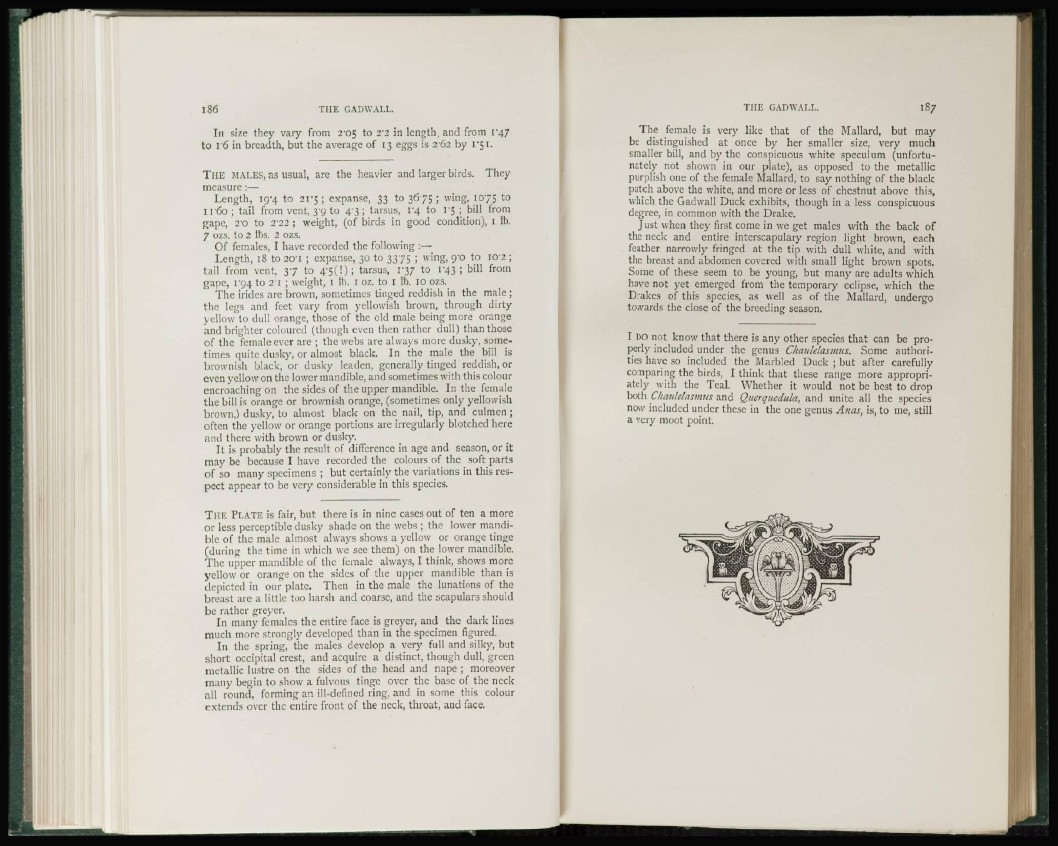
THE GADWALL.
In size they vary from 2-05 to 2'2 in length, and from 14.7
to r6 in breadth, but the average of 13 eggs is 262 by i'51.
THE MALES, as usual, are the heavier and larger birds. They
measure :—
Length, 19-4 to s r j ; expanse, 33 to 3675 ; wing, 1075 to
i r 6 o ; tail from vent, 3'g to 4 3 ; tarsus, 14 to 1*5; bill from
gape, 2'0 to 2'22 ; weight, (of birds in good condition), 1 lb.
7 OZS. to 2 lbs. 2 OZS.
Of females, I have recorded the following :—
Length, 18 to 20'i ; expanse, 30 to 3375 ; wing, 90 to 102 ;
tail from vent, 37 to 4-5(1); tarsus, 1-37 to 143; bill from
gape, i'94 to 21 ; weight, 1 It). 1 oz. to 1 lb. 10 ozs.
The irides arc brown, sometimes tinged reddish in the male ;
the legs and feet vary from yellowish brown, through dirty
yellow to dull orange, those of the old male being more orange
and brighter coloured (though even then rather dull) than those
of the female ever are ; the webs are always more dusky, sometimes
quite dusky, or almost black. In the male the bill is
brownish black, or dusky leaden, generally tinged reddish, or
even yellow on the lower mandible, and sometimes with this colour
encroaching on the sides of the upper mandible. In the female
the bill is orange or brownish orange, (sometimes only yellowish
brown,) dusky, to almost black on the nail, tip, and culmen ;
often the yellow or orange portions are irregularly blotched here
and there with brown or dusky.
It is probably the result of difference in age and season, or it
may be because I have recorded the colours of the soft parts
of so many specimens ; but certainly the variations in this respect
appear to be very considerable in this species.
THE PLATE is fair, but there is in nine cases out of ten a more
or less perceptible dusky shade on the webs ; the lower mandible
of the male almost always shows a yellow or orange tinge
(during the time in which wc see them) on the lower mandible.
The upper mandible of the female always, I think, shows more
yellow or orange on the sides of the upper mandible than is
depicted in our plate. Then in the male the lunations of the
breast are a little too harsh and coarse, and the scapulars should
be rather greyer.
In many females the entire face is greyer, and the dark lines
much more strongly developed than in the specimen figured.
In the spring, the males develop a very full and silky, but
short occipital crest, and acquire a distinct, though dull, green
metallic lustre on the sides of the head and nape ; moreover
many begin to show a fulvous tinge over the base of the neck
all round, forming an ill-defined ring, and in some this colour
extends over the entire front of the neck, throat, and face.
THE GADWALL. I87
The female is very like that of the Mallard, but may
be distinguished at once by her smaller size, very much
smaller bill, and by the conspicuous white speculum (unfortunately
not shown in our plate), as opposed to the metallic
purplish one of the female Mallard, to say nothing of the black
patch above the white, and more or less of chestnut above this,
which the Gadwall Duck exhibits, though in a less conspicuous
degree, in common with the Drake.
Just when they first come in we get males with the back of
the neck and entire interscapulary region light brown, each
feather narrowly fringed at the tip with dull white, and with
the breast and abdomen covered with small light brown spots.
Some of these seem to be young, but many are adults which
have not yet emerged from the temporary eclipse, which the
Drakes of this species, as well as of the Mallard, undergo
towards the close of the breeding season.
I DO not know that there is any other species that can be properly
included under the genus Chaulelasmus. Some authorities
have so included the Marbled Duck ; but after carefully
comparing the birds, I think that these range more appropriately
with the Teal. Whether it would not be best to drop
both Chaulelasmus and Querguedula, and unite all the species
now included under these in the one genus Anas, is, to me, still
a very moot point.
•